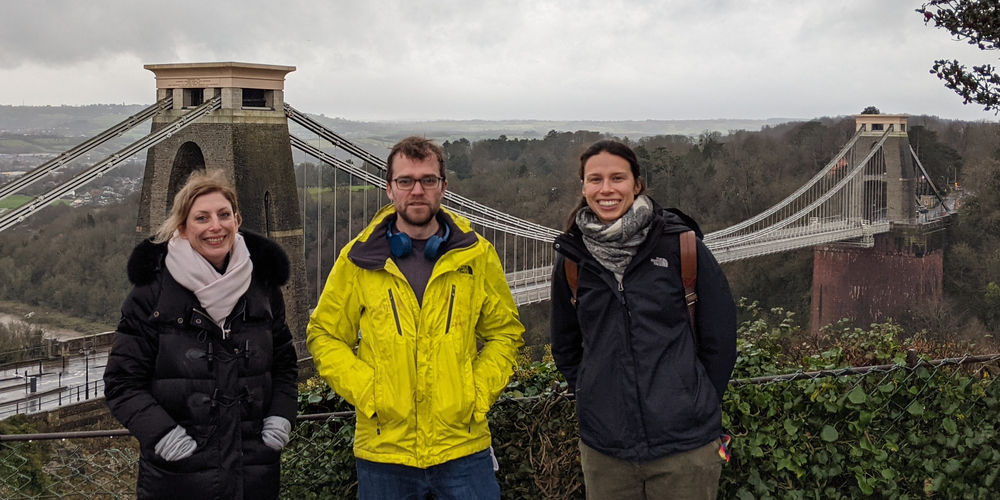Sustaining the Suspension Bridge: digital twinning the built environment
The smooth running of everyday life is hugely dependent on our national infrastructure. Buildings, roads and bridges are all vital to communities and economies on a local and national level. But as the consequences of climate change – such as increased flooding and more violent storms – become increasingly apparent, it is clear that these structures are under threat.
Unfortunately, the risks involved are exacerbated by disjointed infrastructure data and ad-hoc maintenance that often does not discover a problem until it becomes a very costly fix – or worse, lives are put at stake. So the University of Bristol is working on an innovative solution – one that not only stands to ensure the resilience of infrastructure in the face of increasingly severe natural hazards, but which could form the bedrock of an entirely new way of managing all kinds of infrastructure around the world: digital twinning.
Digital twinning is the process of digitally replicating all the facets and features of a real-world object in a 3D computational model and then integrating the real-world data that has an effect on that object. This enables researchers to forecast outcomes and explore different scenarios safely on a computer, rather than navigating the risks that would come with doing so in real life. Digital twinning has already seen widespread applications in the manufacturing sector in the creation and design of new products, but Bristol’s initiative aims to establish it firmly in the built environment, too.
As part of the government-funded UKCRIC (UK Collaboratorium for Research in Infrastructure and Cities) programme, and with the assistance of the Clifton Suspension Bridge Trust and engineering firm COWI, the engineering team at Bristol is conducting trials of its pioneering digital twinning system at the iconic Clifton Suspension Bridge, which spans 412 metres across the River Avon.
Sensing trouble

“We already have some data from the project,” says Dr Maria Pregnolato (pictured top right), whose in-depth work on bridge resilience is helping to guide the research. “The next stage is to develop an interface for the platform. This is the hardest part, because it’s where the novelty of the project resides.” Exactly how this interface should look is dependent on a number of factors. “Real time data collection – which is expensive in terms of resources and time – isn’t always necessary,” says Maria. “So the question now is how to fit updates for purpose. A monthly update could suffice for maintenance monitoring, while more frequent updates would have a useful application during exceptional events, such as extreme weather.”
The team includes Professor Colin Taylor, Professor Theo Tryfonas, Dr Raffaele De Risi, Dr Neil Carhart, Dr Elia Voyagaki (pictured top left), Dr Sam Gunner (pictured in the centre), Miss Gianna Gabriel, Dr Patrick Tully as well as the late Professor John Macdonald who led the studies on the Clifton Suspension Bridge for a number of years until his sudden and untimely death. They are hopeful that a working prototype of the interface will be completed by the end of the year, and that they can look ahead to wider applications for the system.

Looking ahead
She hopes the research will help to build a business case for a more forward-thinking approach to infrastructure management, especially as the technology involved is relatively cheap when compared to the potential consequences of damage and failures. Looking further ahead, there is also plenty of scope for the integration of artificial intelligence and machine learning into the platform, which could help researchers identify novel threats or those forecast within a timeframe outside the usual monitoring period.
Find out more
According to Maria, the ultimate aim of the project is to develop a “national digital twin”. The National Digital Twin programme (NDTp) was first proposed in 2017, with an ambition to create a wide range of twins of different infrastructure types and systems throughout the UK, joined together in a secure and resilient way. So everything from roads and bridges to communication networks and electricity systems could be mapped digitally, enabling authorities to efficiently forecast required maintenance and allocate their resources appropriately. Other countries around the world – Japan, for example – are already working on such a system.
“There’s no question that digitisation is going to play a bigger and bigger role in infrastructure management in the future,” Maria adds. “My hope is that the Clifton Suspension Bridge project will demonstrate how valuable digital twinning can be in the built environment, drive the business case for investment in this area, and ultimately make our infrastructure safer for everyone in the face of increasing risks.”


